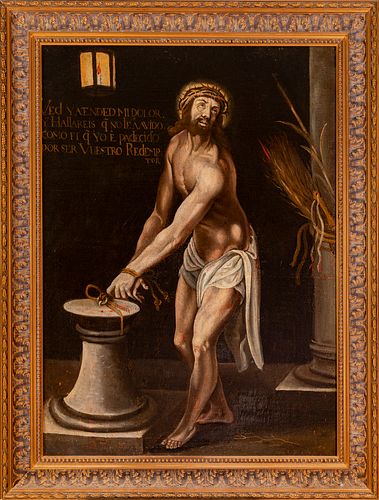Spanish school; second half of the seventeenth century. "Christ tied to the column". Oil on canvas.
Lot 68
About Seller
Setdart Auction House
Carrer Aragó 346
Barcelona
Spain
Setdart Subastas was born in 2004 and is currently the first online art auction in Spain with solidity, prestige and reliability guaranteed by our more than 60,000 users. Setdart has a young, dynamic and enterprising team ready to successfully manage the purchase and sale of art works through custom...Read more
Estimate:
EUR€3,000 - EUR€4,000
$3,225.81 - $4,301.08
Absentee vs Live bid
Two ways to bid:
- Leave a max absentee bid and the platform will bid on your behalf up to your maximum bid during the live auction.
- Bid live during the auction and your bids will be submitted real-time to the auctioneer.
Bid Increments
| Price | Bid Increment |
|---|---|
| EUR€0 | EUR€10 |
| EUR€200 | EUR€25 |
| EUR€500 | EUR€50 |
| EUR€1,000 | EUR€100 |
| EUR€3,000 | EUR€200 |
| EUR€5,000 | EUR€500 |
| EUR€10,000 | EUR€1,000 |
| EUR€20,000 | EUR€2,000 |
| EUR€50,000 | EUR€5,000 |
About Auction
By Setdart Auction House
Nov 3, 2021
Set Reminder
2021-11-03 08:00:00
2021-11-03 08:00:00
America/New_York
Bidsquare
Bidsquare : OLD MASTERS
https://www.bidsquare.com/auctions/setdart-auction-house/old-masters-7786
Setdart Auction House sofia@setdart.com
Setdart Auction House sofia@setdart.com
- Lot Description
Spanish school; second half of the seventeenth century. "Christ tied to the column". Oil on canvas. Presents restorations and repainting. Measurements: 104 x 76 cm; 121 x 94 cm (frame). Devotional painting in which the figure of Christ is appreciated in the center of the composition, tied to a low column. It is the representation of an episode belonging to the cycle of the Passion, a highly dramatic theme, but not narrative, designed to encourage the faithful to be moved by the physical suffering of Christ and to admire his acceptance of the misfortunes he must suffer to redeem humanity. The scene narrated in the Gospels takes place in the Praetorium of Jerusalem, the center of Roman power, where Christ has arrived for the second and last time, after passing through different instances. He is exhibited before the crowd ("Ecce Homo"), who preferred to free Barabbas rather than him and, either before or after this exhibition, he is stripped of his clothes and tied to a pillar, where he will be subjected to mockery regarding his alleged crime, being "king of the Jews", and tortures, including scourging and crowning with thorns. In this scene in particular, the author has tried to transmit a certain intimacy between the faithful and the representation of Jesus, for this reason he has represented him in solitude, without the company of the soldiers. In the center of the composition Jesus is presented to the spectator with the symbols of his penitence, the crown of thorns, his imprisonment in the column, where the blood can be seen, and marks of pain reflected in the wounds of the knees, in addition it is worth mentioning that the author to have a symmetrical composition has chosen to place a column in the left zone, where he places several palms tied to the perimeter of the column, with the intention of transmitting the suffering of Christ. These symbols are reinforced by the presence of a legend "See and heed my pain, and you will find that there has been no pain like the one I suffered, because I am your redeemer". This calligraphic resource alludes directly to the viewer and forces him to have an active attitude towards the image, however, despite the message of suffering, the artist places the words under an illuminated lantern, thus providing the idea of light and hope. Formally this work is related to the naturalistic current of the Baroque that dominated the Spanish school in the first half of the seventeenth century, influenced by Caravaggio and his followers. Thus, we find in the canvas all the basic characteristics of this style. First of all, the tenebrist lighting, artificial, focused and directed towards the most important areas of the composition, creating expressive chiaroscuro and leaving the rest in a nuanced penumbra that speaks of the painter's mastery. On the other hand, the composition is also typical of naturalism: simple, clear and realistic, with Christ in the foreground on a defined background but worked in neutral tones. Finally, we must also highlight the chromatism, very studied and nuanced, with a palette that revolves around ochers, carmines and earthy tones, typically Caravaggist.
- Shipping Info
-
In-house shipping available. Please inquire at admin@setdart.com.
-
- Buyer's Premium



 EUR
EUR CAD
CAD AUD
AUD GBP
GBP MXN
MXN HKD
HKD CNY
CNY MYR
MYR SEK
SEK SGD
SGD CHF
CHF THB
THB












